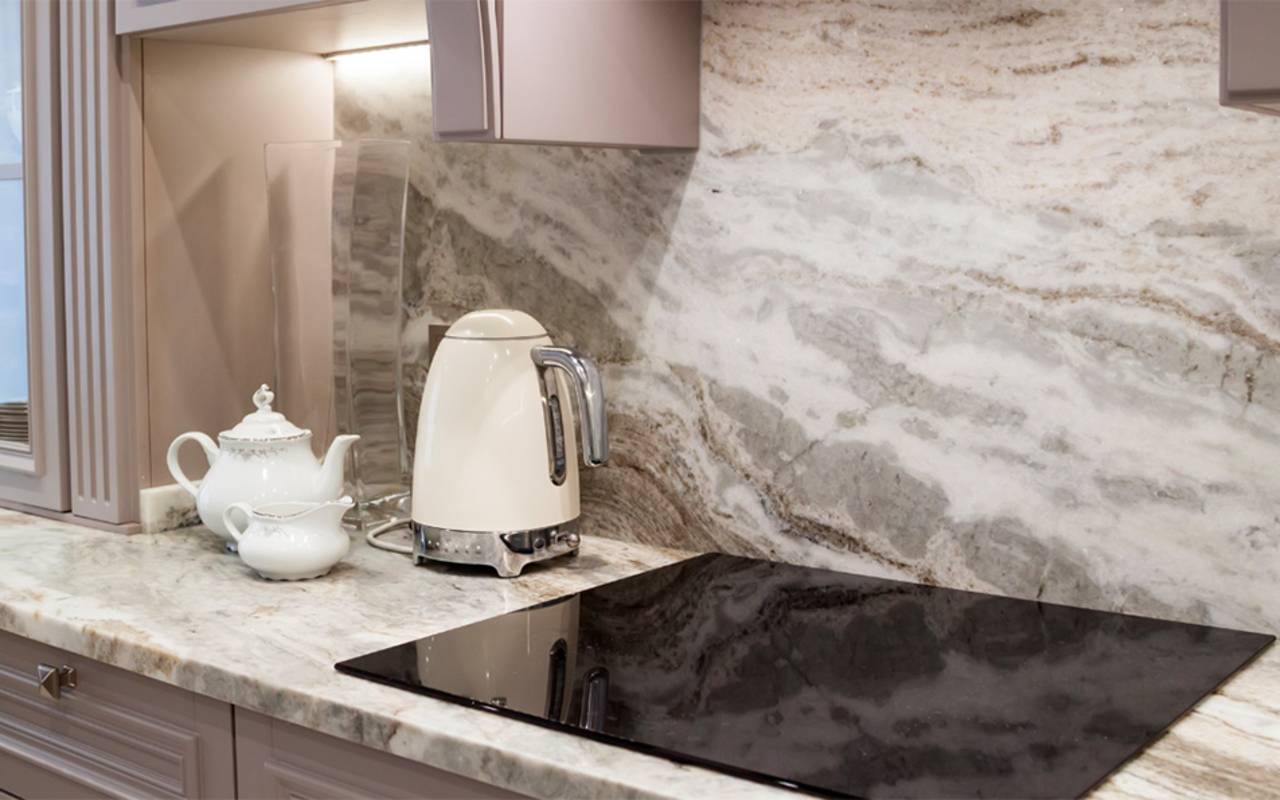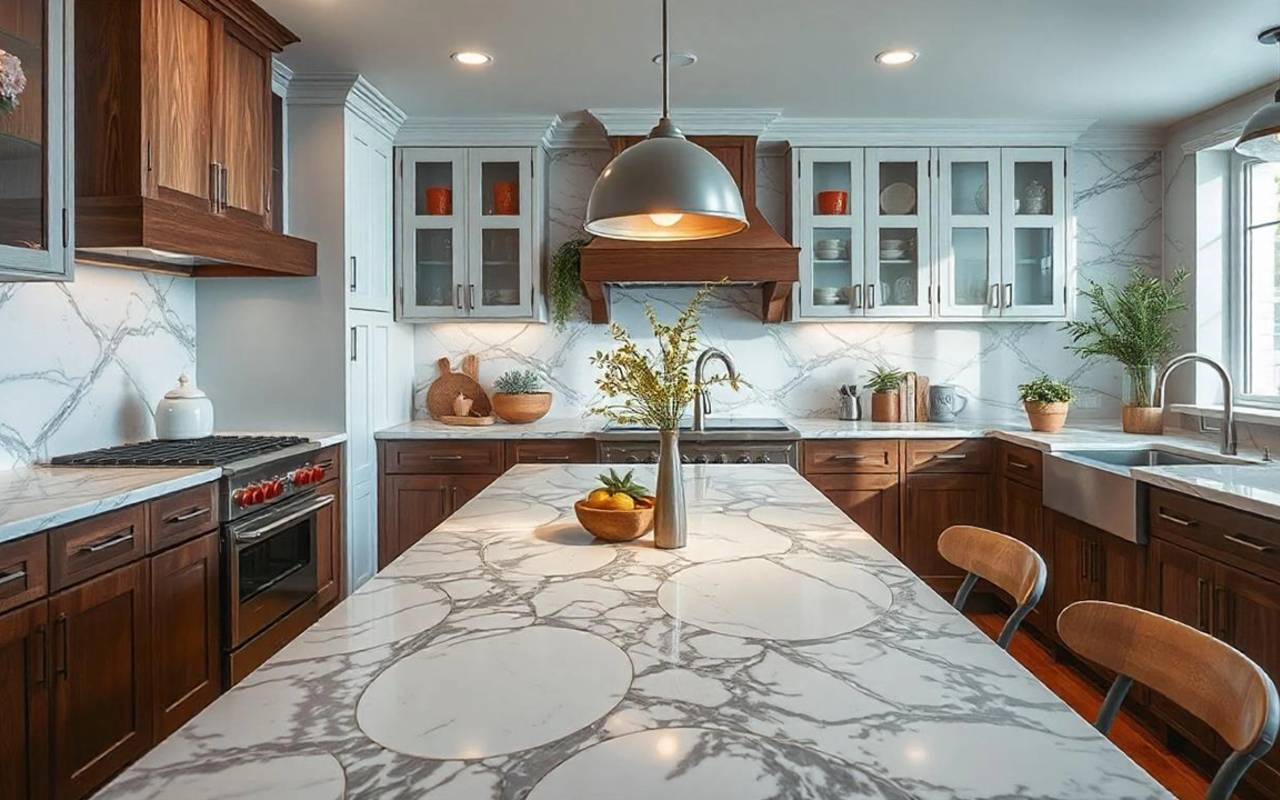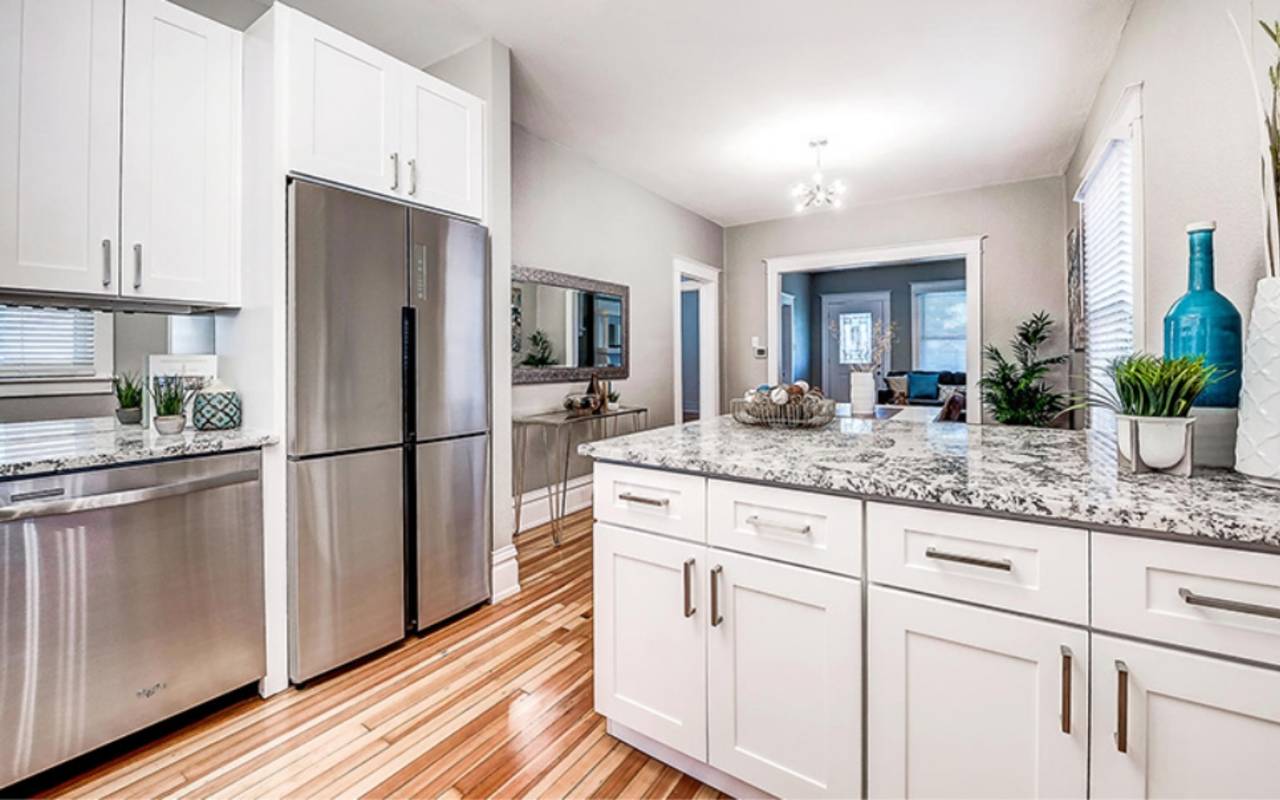Table of Contents
This guide is comprehensive for homeowners, designers, and enthusiasts eager to explore granite countertops and natural stone fabrication. From understanding its formation to stone countertop installation and care, this article delves into every facet of this exceptional material, making your journey through the world of granite as smooth as its polished surface.

What Are Granite Countertops?
Granite countertops are popular for kitchens, bathrooms, and other spaces requiring durable yet aesthetically appealing surfaces. Composed primarily of quartz, feldspar, and mica, granite is a naturally occurring igneous rock formed deep within the Earth’s crust under extreme heat and pressure. This unique formation process gives granite its characteristic durability and stunning patterns.
Check out our guide to bathroom design ideas.
Each granite slab is distinct, with various colors and patterns that can suit virtually any interior design style. Granite’s rich appearance and natural luster make it a premium material for countertops, offering both practicality and a luxurious feel.
Natural Characteristics and Composition
Granite’s hardness ranks just below diamond on the Mohs scale, making it resistant to scratches and wear. It often includes flecks or veins of contrasting minerals, giving it a unique appearance. Its porosity varies, so proper sealing is essential to prevent staining and maintain its look over time.
Advantages of Granite Countertops
- Durability: Granite is highly resistant to scratches, heat, and impacts, making it ideal for high-traffic areas.
- Low Maintenance: When sealed properly, granite is easy to clean and resists stains effectively.
- Unique Aesthetic Appeal: No two granite slabs are identical, ensuring a one-of-a-kind look for every countertop.
- Increased Property Value: Granite countertops are a home selling point, adding perceived value to the property.
Common Misconceptions About Granite
Many believe granite is too high-maintenance or prone to damage, but it is one of the most robust and long-lasting materials available with proper natural stone maintenance and care. Another myth is that granite is outdated, yet its timeless elegance thrives in classic and contemporary designs.
Types of Granite Countertops
Polished Granite Countertops
Polished granite offers a mirror-like surface that highlights granite’s natural colors and patterns. This highly reflective finish makes spaces appear brighter and more spacious. Polished granite is also less porous, providing better stain resistance.
Honed Granite Countertops
Honed granite has a matte finish, offering a softer and more subdued aesthetic. This finish is ideal for those seeking a modern or rustic look. However, due to its slightly higher porosity, it may require more frequent sealing.
Leathered Granite Countertops
Leathered granite features a textured surface that adds depth and tactile interest. This finish is perfect for creating a natural, earthy feel and is less prone to fingerprints and smudges.
Variations in Color and Patterns
Granite comes in various colors, from neutral whites and grays to vibrant blues and reds. Popular patterns include veins, speckles, and swirls, allowing customization based on personal style and design goals.
Related: How to Save on Granite Kitchen Countertops

The Natural Stone Fabrication Process
Quarrying Granite: From Extraction to Blocks
Granite’s journey begins in quarries, where massive blocks of stone are extracted from the Earth. This process involves cutting and removing large rock sections using advanced equipment like diamond-wire saws. Quarrying is done with precision to minimize waste and preserve the integrity of the stone.
Transportation and Initial Processing
After extraction, granite blocks are transported to processing facilities and cut into manageable slabs. This step involves powerful saws sliced through the dense rock with incredible accuracy.
Cutting and Shaping the Slabs
Fabricators use computer-aided design (CAD) software to create precise measurements for cutting granite slabs to fit specific spaces. Advanced machinery, such as CNC routers, ensures intricate cuts for sinks, edges, and custom shapes.
Polishing and Finishing Techniques
Polishing transforms raw granite slabs into stunning surfaces. This multi-step process involves grinding the natural stone countertop with finer abrasives until it achieves the desired finish, whether polished, honed, or leathered.
Quality Control During Fabrication
Every granite slab undergoes rigorous inspection to meet aesthetic and functional standards. Fabricators check for uniformity, structural integrity, and finish quality before delivering the product to clients.

Choosing the Right Granite Countertop
Factors to Consider: Budget, Durability, Style
Balance is key when selecting granite countertops. Consider your budget, the intended use of the space, and your personal style preferences. While granite is durable, certain patterns and colors may suit specific environments better.
Popular Granite Colors and Their Appeal
- White Granite: Creates a clean, modern look.
- Black Granite: Adds drama and sophistication.
- Gray Granite: A versatile choice for various design schemes.
- Exotic Colors: Blues, greens, and reds for bold statements.
Matching Granite With Interior Themes
Granite’s versatility complements diverse themes, from minimalist to opulent designs. For example, subtle white or gray granite works well in Scandinavian-inspired spaces, while bold, exotic hues enhance eclectic and luxurious interiors.
Evaluating Slab Quality
Inspect slabs for cracks, pits, and color consistency. High-quality granite should have a smooth, uniform surface with minimal imperfections. Ask for a sample to test its porosity and durability before purchasing.
Installation Process of Granite Countertops
Preparing the Space
The installation process begins with preparing the designated space. This involves clearing the area, ensuring cabinets and supports are level, and reinforcing structures if needed. Proper preparation ensures the countertop fits seamlessly and remains stable over time.
Customizing Measurements and Cutting
Precise measurements are crucial for a perfect fit. Fabricators create templates of the countertop space, which guide the cutting process. Using specialized tools, granite slabs are cut to match the exact dimensions of the space, including allowances for sinks, cooktops, and edges.
The Role of Adhesive and Sealing
During installation, high-strength adhesives secure the granite to the base cabinets. Sealing the granite is equally important, protecting the stone from stains and moisture. A high-quality sealant penetrates the stone’s pores, creating a protective barrier without altering its natural beauty.
Final Adjustments and Cleaning
After securing the granite, installers make final adjustments to ensure the slab is perfectly aligned. They polish any rough edges and clean the surface thoroughly. The final result is a stunning, durable countertop ready for use.
Benefits of Granite Countertop
Durability and Strength
Granite is one of the most complex natural materials, making it resistant to scratches, chips, and general wear and tear. Its heat resistance ensures it can handle hot pots and pans without damage, making it an excellent choice for kitchens.
Explore more on kitchen remodeling.
Heat and Scratch Resistance
Unlike synthetic materials, granite can withstand high temperatures and abrasive materials. This property makes it ideal for busy households where countertops are frequently used.
Timeless Aesthetic Appeal
Granite’s natural beauty, with its unique patterns and colors, adds an unmatched elegance to any space. Whether polished or honed, its appearance never goes out of style.
Long-Term Value Addition
Investing in granite countertops enhances the look of your home and increases its resale value. Homebuyers often view granite as a premium feature, making properties with granite surfaces more desirable.
Maintenance and Care
Daily Cleaning and Upkeep
Maintaining granite countertops is simple, with routine cleaning. Use a mild soap or stone-safe cleaner and a soft cloth to wipe the surface daily. Avoid harsh chemicals that can degrade the sealant or damage the stone.
Re-Sealing Granite Countertops: When and Why
Granite should be resealed periodically to maintain its resistance to stains and moisture. Most countertops require sealing once a year, but high-quality granite may need less frequent reapplication. Test the seal by sprinkling water on the surface—if it absorbs, it’s time to reseal.
Tips for Stain Prevention
- Wipe spills immediately, especially from acidic substances like wine, citrus, or vinegar.
- Use coasters under beverages and placemats for food preparation.
- Avoid placing hot pans directly on the surface, even though granite is heat-resistant.
Do’s and Don’ts for Longevity
- Do: Use cutting boards and trivets to protect the surface.
- Don’t: Use abrasive pads or cleaners that may scratch or dull the finish.
Cost of Granite Countertops
Average Cost Per Square Foot
The cost of granite countertops typically ranges from $40 to $200 per square foot, depending on the stone’s quality, rarity, and finish. Exotic patterns and colors are often at the higher end of this range.
Additional Expenses During Installation
Custom cuts, edge profiles, and installation labor can add to the cost. Investigating these additional expenses is essential when budgeting for granite countertops.
Budget-Friendly Tips for Purchasing Granite
- Opt for standard colors and patterns, usually more affordable than exotic varieties.
- Look for remnants or discounted slabs for smaller projects.
- Compare quotes from multiple fabricators to find the best deal.
Comparing Granite to Other Materials
Granite vs. Quartz
Granite is 100% natural, while quartz is engineered with resin and crushed stone. Granite offers unique patterns and a natural aesthetic, whereas quartz provides uniformity and lower maintenance. Both materials are durable, but granite’s heat resistance gives it an edge in kitchens.
Granite vs. Marble
Marble is softer and more porous than granite, making it prone to scratches and stains. While marble exudes elegance, granite is better suited for high-traffic areas due to its superior durability.
Pro Tip: Make a Lasting Impression with Granite and marble reception desks instantly elevate the look and feel of any business environment, creating a strong first impression for clients and visitors. These natural stone materials convey professionalism, luxury, and attention to detail—qualities that reflect positively on your brand. Choosing granite or marble for your reception area helps establish trust, reinforce your brand image, and set the tone for a high-end customer experience.
Granite vs. Soapstone
Soapstone is a softer material with a smooth, matte finish. While it offers a unique look, it requires more maintenance than granite. Granite’s durability and variety of colors make it a more versatile choice.
Key Differentiators and Use Cases
Each material has its strengths, but granite stands out for its combination of natural beauty, durability, and low maintenance. Its versatility makes it ideal for countertops, floors, and outdoor applications.
Eco-Friendly Aspects of Granite
Sustainability in Quarrying and Fabrication
Granite is a naturally occurring material, and advancements in quarrying technology have reduced its environmental impact. Modern methods focus on minimizing waste and preserving ecosystems surrounding quarries. Some manufacturers even source granite remnants to create smaller slabs, reducing waste further.
Recycling Granite Remnants
Granite remnants, the leftover pieces from larger projects, are often repurposed for smaller countertops, backsplashes, or decorative features. This recycling process reduces material waste and offers a budget-friendly option for homeowners seeking the elegance of granite on a smaller scale.
Environmental Benefits of Long-Lasting Materials
Granite’s durability and longevity mean it seldom needs replacement, reducing the environmental footprint associated with frequent remodeling. Unlike synthetic materials that wear out quickly, granite countertops can last for decades, making them a sustainable choice for eco-conscious homeowners.
Myths About Granite Countertops
Debunking Common Granite Myths
- Myth 1: Granite is radioactive.
While granite contains trace amounts of naturally occurring radioactive elements, the levels are far below what is considered harmful. Scientific studies confirm that granite is safe for residential and commercial use. - Myth 2: Granite is high-maintenance.
Properly sealed granite countertops require minimal maintenance, making them an easy-to-care-for option in busy households. - Myth 3: Granite is outdated.
Granite’s timeless appeal ensures it remains a favorite choice for homeowners and designers. It blends seamlessly with both traditional and modern aesthetics.
Clarifying Misconceptions About Durability and Maintenance
Granite is often mistaken as fragile or prone to damage. In reality, it’s one of the most robust countertop materials available. Its hardness and proper sealing make it resistant to scratches, stains, and heat.
Popular Uses of Granite Beyond Countertops
Flooring and Tiles
Granite’s durability and natural beauty make it an excellent choice for flooring. Its ability to withstand heavy foot traffic and its resistance to moisture and stains makes it ideal for high-traffic areas like foyers, hallways, and kitchens.
Outdoor Applications: Patios and Kitchens
Granite is perfect for outdoor settings due to its resistance to weathering. It’s commonly used for patio surfaces, outdoor kitchens, and fire pits, providing a durable and elegant option for exterior spaces.
Granite in Art and Sculpture
Artists and sculptors have long valued granite for its workability and stunning finish. From intricate statues to decorative installations, granite’s versatility extends far beyond functional applications, making it a preferred material for artistic expression.
Innovations in Granite Fabrication
Advancements in Cutting Technology
State-of-the-art machinery, such as laser-guided saws and waterjet cutters, has revolutionized granite fabrication. These tools enable precise cuts and intricate designs, minimizing waste and enhancing the quality of finished products.
The Impact of Automation on Quality
Automation in fabrication processes has increased efficiency while maintaining high standards of quality. Computer Numerical Control (CNC) machines ensure every cut, edge, and detail is executed precisely, reducing human error and improving overall consistency.
Unique Design Trends in Granite Fabrication
Granite fabricators are now exploring innovative edge profiles, mixed-material designs, and custom patterns. These trends allow homeowners to personalize their countertops, blending functionality with artistic expression.
Finding a Trusted Granite Fabricator
Key Qualities of a Reputable Fabricator
A trusted fabricator should have extensive experience, a strong portfolio, and excellent customer reviews. Look for professionals who prioritize quality, transparency, and customer satisfaction.
How to Evaluate Online Reviews and Referrals
Online reviews and referrals can provide valuable insights into a fabricator’s reliability and expertise. Focus on detailed reviews that highlight the quality of the work, communication, and timeliness.
Questions to Ask Before Hiring
- What types of granite do you offer?
- Can I see samples of previous projects?
- What is the expected timeline for installation?
- Do you provide warranties or guarantees for your work?
Conclusion
Granite countertops are more than just a functional addition to your home—they are a statement of elegance, durability, and timeless appeal. From understanding the natural beauty of granite to exploring the fabrication and installation processes, this guide has covered every aspect of these exceptional surfaces.
Whether you’re remodeling your kitchen, designing a luxurious bathroom, or adding value to your home, granite is an investment worth considering. Its unmatched durability, unique patterns, and eco-friendly properties make it a favorite among homeowners and designers.
With proper care and maintenance, granite countertops can last a lifetime, providing beauty and functionality that stand the test of time. Explore the world of granite and transform your space with the enduring charm of natural stone.
FAQs About Granite Countertops and Natural Stone Fabrication
What makes granite a good material for countertops?
Granite is highly durable, heat-resistant, scratch-resistant, and has a timeless aesthetic appeal. Its unique natural patterns and ability to withstand heavy use make it an ideal material for countertops.
How do I know if my granite countertops need to be sealed?
Perform a simple water test: sprinkle a few drops of water on the surface. If the water is absorbed or darkens the granite, it’s time to reseal. Most countertops require sealing every 1–3 years, depending on usage.
Can granite countertops crack or chip?
Granite is extremely durable, but excessive force, such as dropping a heavy object on an edge, could cause chipping. Cracks are rare and usually occur during improper installation or extreme stress.
Are granite countertops safe for food preparation?
Yes, granite is safe for food preparation when sealed properly. The seal prevents bacteria and stains from penetrating the stone, ensuring a hygienic surface for kitchen use.
What is the average lifespan of granite countertops?
With proper care and maintenance, granite countertops can last for decades—often as long as the home itself. Their durability and resistance to wear make them a long-term investment.
Can I cut directly on granite countertops?
While granite is scratch-resistant, cutting directly on it can dull knives. To protect your tools and maintain the countertop’s finish, it’s best to use a cutting board.
How do I clean granite countertops?
Use a mild soap or stone-safe cleaner and a soft cloth. Avoid harsh chemicals, acidic cleaners, or abrasive pads, as these can damage the sealant and dull the finish.
Is granite environmentally friendly?
Granite is a natural material that lasts for decades, reducing the need for replacement and lowering its environmental impact over time. Quarrying and fabrication have also become more sustainable with modern practices.
What is the difference between polished and honed granite?
Polished granite has a shiny, reflective surface that highlights its natural colors and patterns, while honed granite has a matte finish, offering a softer, more understated appearance.
Can I use granite outdoors?
Granite is weather-resistant and ideal for outdoor applications such as patios, kitchens, and fire pits. However, to protect it from stains and weathering, it must be sealed properly.
Why are some granite slabs more expensive than others?
The price of granite depends on factors like rarity, color, pattern, origin, and the difficulty of extraction. Exotic or rare patterns tend to be more expensive than common varieties.
What should I consider when selecting a granite slab?
Look for consistent color and pattern, inspect for cracks or imperfections, and consider the slab’s thickness. Choose a slab that complements your interior design and fits within your budget.
How long does granite countertop installation take?
The installation process typically takes 1–2 days. However, depending on the complexity of the project, the overall timeline, including fabrication and preparation, can range from 1–4 weeks.
Can granite countertops be repaired if they chip or crack?
Yes, minor chips can be repaired using epoxy or resin mixed with granite dust. For larger cracks or damages, professional fabricators can seamlessly restore the countertop.
Do granite countertops increase home value?
Yes, granite countertops are considered a premium feature and can significantly enhance a home’s resale value, making it a worthwhile investment.
Are all granite slabs heat-resistant?
Granite is naturally heat-resistant, but rapid temperature changes (thermal shock) should be avoided. To maintain the stone’s integrity, use trivets or pads for extremely hot items.

